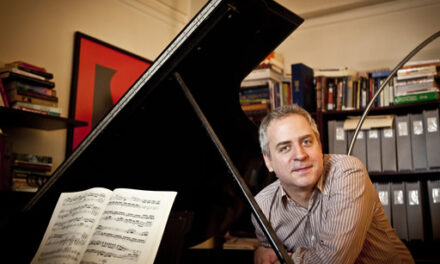The rather aggressive title of the program was “London, Argentina, Infinity … and Beyond.” But the Raleigh Civic Chamber Orchestra delivered on all counts in the Titmus Theatre on the campus of North Carolina State University. On a truly bracing fall afternoon and before a goodly crowd, the players presented their “premiere” performance under Peter Askim, highly honored and credentialed new conductor and composer, as well as director of orchestral activities at NC State. Undoubtedly many there were eager to determine whether the group has maintained the level of excellence attained under retired longtime conductor Randolph Foy. They found ample reason to feel optimistic.
The London connection was established as the group launched into Haydn’s Symphony No. 104, widely referred to as the composer’s “London” symphony. The players attacked this work with a vengeance not usually associated with “Papa Haydn” but probably reflective of the new director’s well-crafted athleticism and their own self-confidence. Throughout the Andante movement and the familiar Minuet, the vigorous reading was highly satisfying. One attendee judged that it brought the work well toward more modern romanticism.
After intermission it was time to augment the forces and move forward a couple of centuries for the Argentina and Infinity sections. The American composer Pierre Jalbert produced “Les espaces infinis” (The Infinite Spaces) in 2001. According to the fine program notes, “It is meant to evoke a sense of spaciousness and timelessness.” Such a sense was promoted by the beginning barely audible strings, gradually building to a frenzy and back again to inaudibility. The mysteriousness was enhanced throughout by the haunting harp.
If you have a yen for a “sound spectacular,” you could hardly improve upon this group’s rendition of Argentinian composer Alberto Ginastera‘s Dances from Estancia, Op 8a (1941). Employing extra horns, a prominent piano, and no fewer than six percussionists, Askim here has certainly brought forth a genuinely exciting showpiece. The “Trabajadores agricolas” and the “Peones de hacienda” showed off the rhythmic vitality of the Argentine countryside.
Note to NC State theater management: Casting the audience into Stygian darkness for the performances renders it impossible to consult the useful program notes and to stay current with such data as movement titles. Would a few f-stops worth of lighting be too much to ask?
Note to well-wishers and fans of the Raleigh Civic Symphony Association: On the basis of this one afternoon, any anxieties you might have harbored can be safely put to rest. It is highly probable that this energetic young conductor and the committed musicians are all set to carry on in the first-rate tradition set by their honored predecessors. Readers may hear the full orchestra on November 16. For details, click here.











